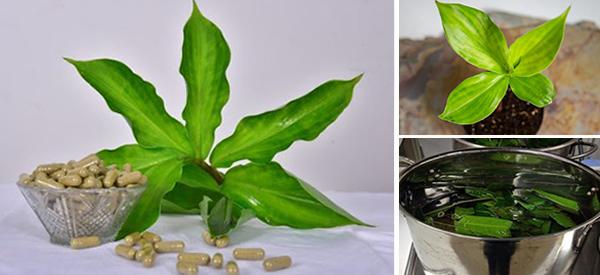
The Insulin Plant – Costus Igneus
Currently, an estimated 537 million adults ages 20-79 years old suffer from diabetes according to the International Diabetes Federation. While many of these individuals seek out western medicine practices, others prefer a more holistic approach, one of which is using the Indian plant, Costus Igneus, as an herbal remedy. Called many names, including step ladder, spiral flag, fiery costus, and the insulin plant, it is this last nickname that gives the Costus Igneus its star value. Belonging to the family of Costaceae, which consists of nearly 150 species, what sets Costus Igneus apart from the rest of its family members is its powerful medicinal properties in regulating insulin in the human body.
Medicinal Benefits
While many parts of the insulin plant provide health benefits, it’s the leaves, specifically, that host its most impressive quality. Rich in Phyto-compound nutrients that simulate the metabolic action of insulin upon ingestion, consuming insulin plant leaves has the ability to lower blood sugar levels in individuals with diabetes.
The diabetic mellitus marvels of the insulin plant continue to come to light as the findings from clinical studies grow momentum. At this time, more than 15 clinical studies have proven the benefits of consuming various forms of Costus Igneus on a daily basis. One study in particular published by the Journal of Clinical and Diagnostic Research discovered the following significant findings when consuming the insulin plant daily:
- All patients saw a statistically significant improvement in blood sugar levels
- All patients were able to reduce their insulin dose by half
- Even patients that failed to control their blood sugar using oral hypoglycemic drugs and non-allopathic medications were able to control their glucose levels using Costus Igneus
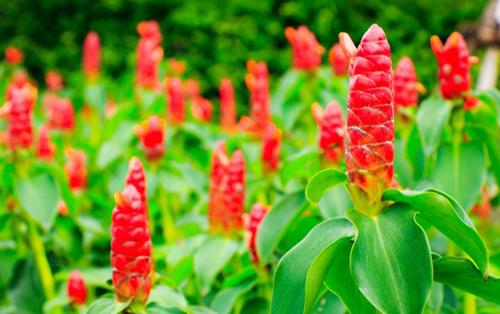
In addition to its diabetes management benefits, the insulin plant leaves are also rich in iron and several antioxidant components, like B-carotene and a-tocopherol. These nutrients, among others, that are found in the insulin plant leaves have been shown to help boost immunity, aid sore throats, improve skin health, maintain kidney and bladder health, and reduce high cholesterol and blood pressure.
Where to Find The Insulin Plant
Thriving best in tropical climates, the insulin plant costus igneus is native to south and central America. However, it is popularly cultivated in gardens of Southern India, specifically Kashmir and the Himalayan regions. The insulin plant stands 2-3 feet from the ground with a reddish-brown stalk. It displays wide leaves, which are 4-8 inches long, and range in color from a very dark green hue to lime green. Blooming among the leaves are vibrant orangish-red flowers that are packed with nutrients and are described as sweet in flavor.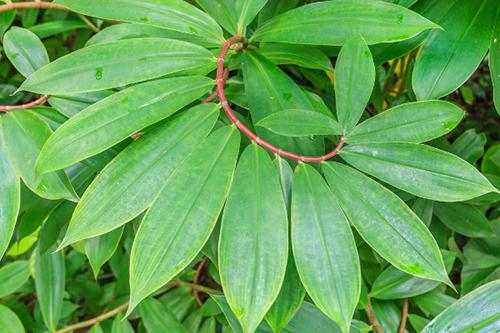
If you are looking to buy the beneficial insulin plant to grow at home yourself, you may be able to find them at local nurseries and plant sellers that provide the full plant or the seeds. Many Ayurveda stores sell insulin plants, as well. If you’re unable to find a local seller that supplies insulin plants, you can purchase them through online stores.
How to Grow It At Home
When grown outside, costus igneus is versatile and low maintenance. Due to its love of warmer, tropical-like climates, it grows best in 9b through 11 growing zones. For the United States, these zones typically encompass California, Texas, Louisiana, Florida, and other southern areas. Insulin plants are best planted in the early spring and typically blossom in temperatures ranging from 35 to 45 degrees.
- Choose a Planting Location: The insulin plant can adjust to growing in various textures and qualities of soil but prefers rich and well-draining soil. It can grow in full sun in milder climates or partial shade in hotter climates. The insulin plant enjoys moisture from soil and air and is often planted near water.
- Dig a Planting Hole: Costus igneus does not require deep planting. Dig beds 2 to 3 inches deep, and 2 to 3 feet apart from one another to allow room for growth.
- Add Compost for Optimum Foliage: This will improve drainage of the soil.
- Add Fertilizer: Use a general-purpose fertilizer in the spring to double the potency of the soil, and then monthly during the summer months. We have a list of 13 homemade fertilizers you can consider here.
- Use Organic Mulch: Scatter woodchips and other forms of organic mulch around the herb, especially to help insulate the plant during the winter months. Mulch should not be in contact with the plant stem. Refrain from over-watering the plant in the winter months.

For growing indoors, the following things should be considered:
- The insulin plant grows as a container plant.
- Mulch of the plant should be removed at the time of fertilizing but should be replaced immediately after that.
- The insulin plant grows best when placed in an area that gets both sun and shade. It needs at least 3 to 4 hours of sunlight.
- It is best suited in fertile and moist soil. There should not be water logging and the soil should be well-drained.
- The soil of this plant should be kept moist but not soggy. Avoid overwatering.
At-Home Remedies
The home remedies using the insulin plant are typically derived from the plant’s leaves. The fructose that is present in the leaves has been found to help regulate increased blood sugar levels and effectively treat diabetes. The beneficial properties of the insulin plant leaves can be extracted and used for medicinal purposes in the following three ways:

- Chew on a raw leaf of the plant.
- Dry the leaves and grind them into a powder, then combine the powder with water and drink.
- Create a decoction by boiling a few leaves for 10 minutes, straining the mixture, and then drinking the water.
Recommended Dosage
While some sources indicate specific dosage recommendations (i.e., consuming one raw leaf per day, or consuming one tablespoon of powder per day), the appropriate dose of the insulin plant depends on several factors such as the user’s age, state of health, and several other conditions. At this time, there is not enough scientific information to determine an appropriate range of doses for the insulin plant. Keep in mind that natural products are not always necessarily safe and dosages are important.
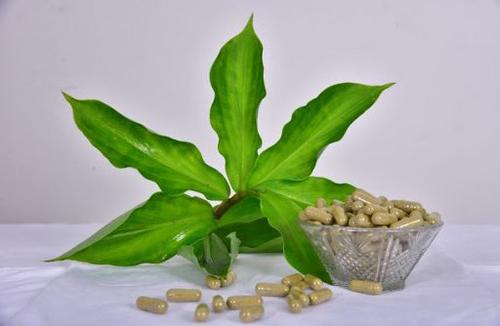
Be sure to consult your pharmacist, physician, and/or another healthcare professional before using Costus Igneus as herbal medicine.
Precautions and warnings
Certain herbal medicines can interact with other medications that you are using. This may increase the risk of toxicity and/or drug reactions. Before taking herbal medication, always discuss it with your doctor. In addition, certain populations may be at greater risk of negative side effects from using the insulin plant as an herbal medication.
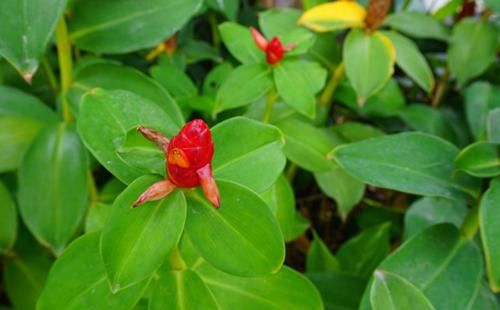
It is important to check with your healthcare provider before taking insulin plant remedies if you fall into any of the following categories:
- Individuals that use hypoglycemic agents or insulin for diabetes management
- Have any known allergies to medications, foods, and/or substances
- Have any known health problems, such as liver or kidney damage
- Are pregnant or breastfeeding
- Have an allergy to ragweed and related plants: C. igneus may cause an allergic reaction in individuals that are allergic to the Asteraceae/Compositae plant family, which include ragweed, chrysanthemums, marigolds, daisies, and many other plants.
Aristolochic Acid Warning
Insulin plant oil, root powder, raw leaf, leaf powder, or tincture is likely safe for most people when taken orally in amounts found in foods. However, costus igneus often contains aristolochic acid, a contaminant that can cause damage to the kidneys. Insulin plant products that contain aristolochic acid are UNSAFE. Under the law, the Food and Drug Administration (FDA) can confiscate any plant product that is believed to contain aristolochic acid.
You may also like:
 How To Make Your Own Natural Sweetener for Diabetes
How To Make Your Own Natural Sweetener for Diabetes
The Plant That Is Sweeter Than Sugar And Helps People With Diabetes (Video)
Foods and Herbs to Avoid When You Have Diabetes

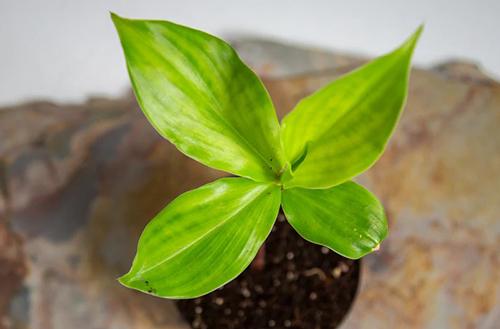
No where in the article did I see the proper name of the plant.
At the beginning of the article it states the name, Indian Plant, or Costus Igneus.
What is the proper name?
Where can I locate this plant in Oregon
Costus Igneus. Belonging to the family of Costaceae, which consists of nearly 150 species. It is in the first paragraph.
Costus Igneus, I think is the name
Costus Igneus, in the first paragrah
Costus igneus, it’s in the last line under Recommended Dosage
Costus Igneus
Costus Igneus
Up at the top in the first paragraph it told the name. Costus Igneus,
You need to click on the link…
Chamaecostus cuspidatus, common name fiery costus or spiral flag, is a species of herbaceous plant in the family Costaceae native to eastern Brazil (States of Bahia and Espirito Santo).[1][2][3] In India, it is known as insulin plant for its purported anti-diabetic properties.[4][5]
Which of the varients contains aristolochic acid and which does not contain it? You state that the insulin plant “often” aristolochic acid, is this because of a generic defect; impromptu development during the growing phase? Is it only possible to determine this with a lab test?
Hi Gerdus,
When you buy an Insulin Plant supplement, is it best to look for a certified brand or one that is made in an FDA-registered facility. This way you will know that it does not contain aristolochic acid and it is safe to use.
You can also find more details about the aristolochic acid here:
https://www.accessdata.fda.gov/cms_ia/importalert_141.html
https://ntp.niehs.nih.gov/ntp/roc/content/profiles/aristolochicacids.pdf
https://monographs.iarc.who.int/wp-content/uploads/2018/06/mono100A-23.pdf
https://www.ncbi.nlm.nih.gov/pmc/articles/PMC3931203/
Many blessings and good health!
Can you recommend a lab that can test for aristolochic acid? Can you quantify wht percentage of plants contain it? Is it caused by malnutrition of the plant?
The plant sounds tantalizing, but “often” risking my kidneys and developing cancer are a mite off-putting.
Thanks!
Hi Yargew,
When you buy Insulin Plant supplements, is it best to look for a certified brand or one that is made in an FDA-registered facility. This way you will know that it does not contain aristolochic acid and it is safe to use.
You can also find more details about the aristolochic acid here:
https://www.accessdata.fda.gov/cms_ia/importalert_141.html
https://ntp.niehs.nih.gov/ntp/roc/content/profiles/aristolochicacids.pdf
https://monographs.iarc.who.int/wp-content/uploads/2018/06/mono100A-23.pdf
https://www.ncbi.nlm.nih.gov/pmc/articles/PMC3931203/
Many blessings and good health!
Can you send me something on prostrate cancer??
Nature’s Costus Igneus Shield
https://amzn.to/3xfF3Z9
Live Plant Cuttings – Insulin Plant
https://amzn.to/3r5VkvJ
1 Live Insulin Plant Bulb
https://amzn.to/3NOc0lr
This is very interesting. It is possible to find capsules, while i’m hunting for the plant. I already have Moringa and use 1+teas (air dried) a day, think I’d like to add this to the mix. Thank you for so much information. Many Blessings.
Insulin Plant(3 Live plants with Rhizomes) Fiery Costus /Costus Igneus, Blood Sugar Support https://smile.amazon.com/dp/B08YFKB5QJ/ref=cm_sw_r_cp_api_i_B1PGP6WK6AENZSGYYS5Q
So how do I know whether an insulin plant actually DOES or DOES NOT contain aristolochic acid?
Hi Pauline,
When you buy Insulin Plant supplements, is it best to look for a certified brand or one that is made in an FDA-registered facility. This way you will know that it does not contain aristolochic acid and it is safe to use.
You can also find more details about the aristolochic acid here:
https://www.accessdata.fda.gov/cms_ia/importalert_141.html
https://ntp.niehs.nih.gov/ntp/roc/content/profiles/aristolochicacids.pdf
https://monographs.iarc.who.int/wp-content/uploads/2018/06/mono100A-23.pdf
https://www.ncbi.nlm.nih.gov/pmc/articles/PMC3931203/
Many blessings and good health!
Hello,
People do NOT want to know about the supplements that contain aristolochic. They want to know about the LIVE PLANT and whether the leaves contain aristolochic when consumed raw. We are not interested in the supplements. We want to know about the live plant.
Thank you
I live in Australia were can I buy this ???
Ditto on where I can I find this in Oregon. I would like to be able to purchase the leaves to grind myself and encapsulate.
Etsy. I purchased 6 plants and they are doing well!
great article especially for a diabetic that has farming as a hobby and has the space and time
Regarding the aristolochic acid, how do we know if the plant is making this? Are there species in this family which don’t have it? I could not find a reply to the questions posed above on this.
Hi Noreen,
When you buy Insulin Plant supplements, is it best to look for a certified brand or one that is made in an FDA-registered facility. This way you will know that it does not contain aristolochic acid and it is safe to use.
You can also find more details about the aristolochic acid here:
https://www.accessdata.fda.gov/cms_ia/importalert_141.html
https://ntp.niehs.nih.gov/ntp/roc/content/profiles/aristolochicacids.pdf
https://monographs.iarc.who.int/wp-content/uploads/2018/06/mono100A-23.pdf
https://www.ncbi.nlm.nih.gov/pmc/articles/PMC3931203/
Many blessings and good health!
Is the insulin plant also safe for TYPE 1 diabetes? For which most people are insulin dependent, and the pancreas cells are permanently damaged?
I have looked both in my regular nurseries where I source unusual or uncommon plants, but can’t find this one anywhere. I am in Australia, so can’t go to either Etsy or Amazon for the plant as our quarantine laws are (rightfully) very strict. Anyone know where in Australia I could source these plants?
Regarding the aristolochic acid
I guess because of the multiple requests for information about aristolochic acid & all of the replies saying purchase supplements from a reputable company & NEVER actually addressing the question of “HOW DO YOU KNOW IF YOUR PLANT THAT YOU’RE GROWING AT HOME IS CONTAMINATED OR NOT OR WHAT VARIETY IS SAFE”, you have to determine, there is no way to tell if the plant you’re growing at home is toxic or not, you just have to try it & if you start seeing signs of cancer or kidney failure, stop using it. That’s all I can gather from all the questions & answers I have read. I was very interested in this plant until discovering this.
Clarification is still needed on the aristolochic acid. Please do not give the same automated reply to the aristolochic acid questions. The article says the plants can have aristolochic acid. But the reply refers to purchased products maybe containing aristolochic acid. May we please hear from Nicole who will clarify for us. Please not another repeat of the same unhelpful reply. Thank you
YES! I don’t understand the lack of straightforward information on safely growing our own. This is extremely disheartening and it makes the entire email feel like clickbait.
I mentioned Cortisolic acid. That is found in Costus Igneus, also called the Insulin Plant. I just finished 60 days. I’m still tapering to the “maintenance” one dose a day. I purchased the capsules from a company in Texas, pills made in an FDA facility. I expect to buy the plant in the fall. I’ll grow then process my own. I used the capsules to be sure they will work for me.
Another plant whose leaves also produce Cortisolic acid is the Mango tree. Expect to plant that this fall. Look up both plants on the internet, check the facts, I did. BTW, The Insulin Plant is used in the Ayurvedic system and has been known in India for hundreds of years.
I live in Queensland Australia and I would like know where I can purchase a Costus Igneus here in Australia or am I able to purchase it from America?
This is a link to something called Diabetes Plant, not specifically the Costus but work exploring. https://www.rareplants.net.au/product-category/diabetes-plant/
Yes, I found this link as well. They sound identical in action and almost look the same but the scientific name is Gynura procumbens. Would love to know the difference. I am in QLD too. 🙂
I live in New Zealand where can I buy this plant.
New Zealand laws security do not allow foreign plants into the country. Is there a New Zealand plant that has the simular or same nutrients. Or where can I source this in New Zealand.
This plant sounds promising. I have diabetes and take supplements for it. You mentioned it should not be taken if allergic to ragweed. Among the many things I am allergic to ragweed is one..Could you explain further the coalition between insulin plant and ragweed..Also how dangerous is it if a person who has ragweed allergy takes this place.
Amazon carries many choices
While I know you have to state that everyone should consult their physician before attempting to take or apply these remedies due to legal and liability issues, I’ve had doctors before tell me to not trust any herbal remedies. The doctors would lose out on $$ from big pharma if their patients stopped taking their prescribed medications. Makes it difficult to have those conversations with the doctor if they stand to lose $$.
Can you suggest a couple of website that you trust to purchase herbs/powders from?
How long does it take to harvest an insulin plant ?